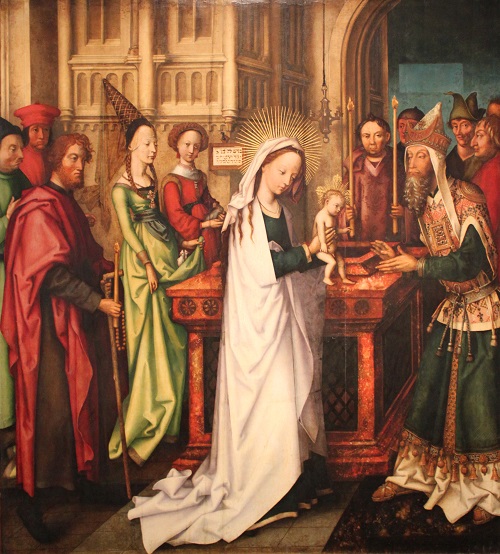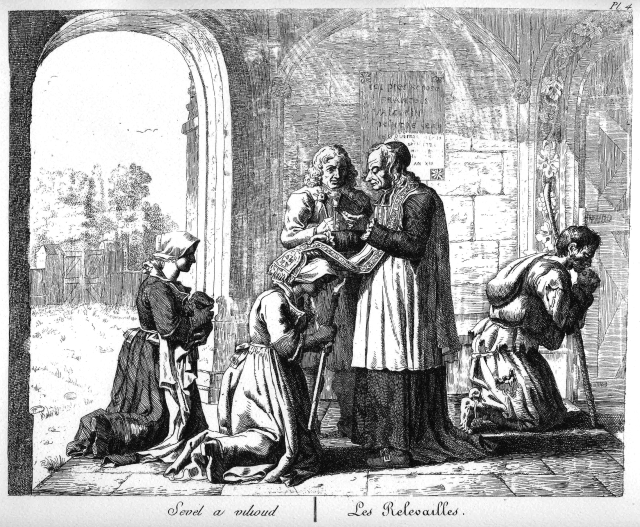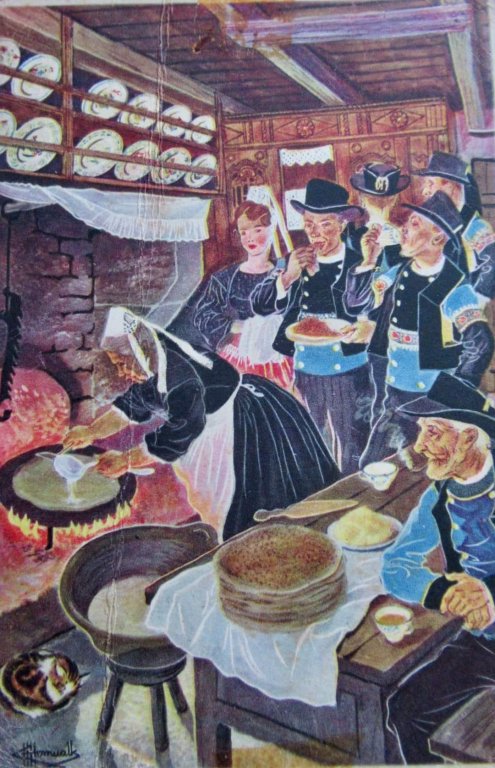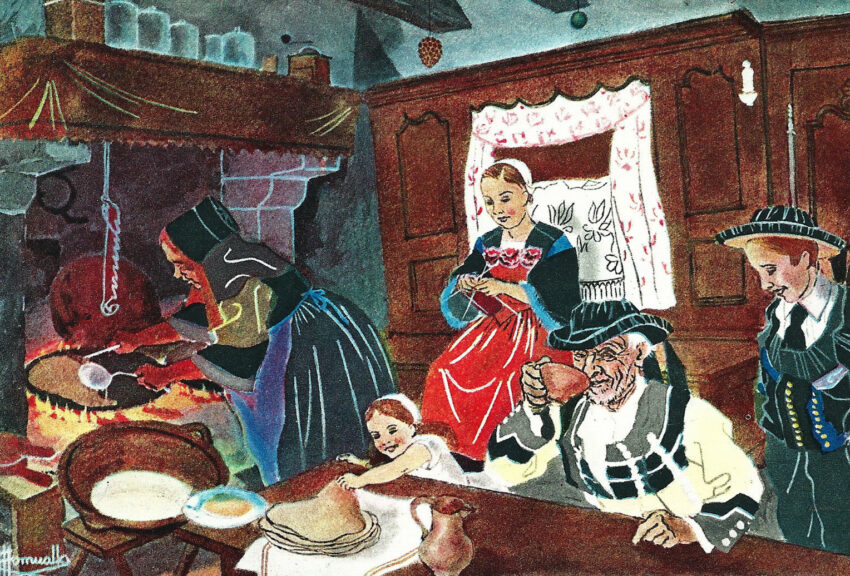Like every day, February 2nd is another day to celebrate France’s delicious gastronomy.
Unlike every day, crêpes dominate the day.
When I first moved here and encountered free (yes, free) crêpes being handed out this day, I asked my husband “is it like national donut day, but crêpes because we are in France?” Sorry to be the bearer of bad news, but it turns out that National Crêpe Day does not exist here. What does exist, instead, is a (Christian) holiday with deep-rooted traditions that so happens to translate to free crêpes…


February 2: The Day of Three Feasts
This holiday is actually a celebration of three different celebrations: the Feast of the Presentation, Relevailles AND Chandeleur.
The Presentation & Relevailles
The Feast of the Presentation marks the presentation of the baby Jesus in the Temple of Jerusalem. This takes place 40 days after his birth (aka February 2). Why 40 days? In this period, women, after having given birth, were “impure” and unable to approach the Temple or holy things. To ensure her return to the Temple as a chaste woman, she was purified of her blood. Such a purification process took 40 days for those birthing a son and 80 for those birthing a daughter.

Following this period was the ceremony of “Relevailles” as it is called in French. This ceremony has the purpose of purifying the “unclean” women as to reintegrate them into the church. Women came to the Temple with an offering: “a lamb of the first year for the burnt offering and a dove or a turtle-dove for the sacrifice of atonement” (if she was poor, she could offer two doves or two pigeons).

It is due to the presentation of Jesus at the Temple as well as these purity rituals that many now associate Chandeleur with the Virgin Mary.
Putting the “Chandelle” in “Chandeleur”
The word “Chandeleur,” also known as Candlemas in English, comes from the Latin “festa candelarum,” or the “feast of candles.”
It seems that Pope Gelasius introduced this “festa candelarum” to Rome in the late 5th century C.E. This feast consisted of blessing the candles followed by a candlelight procession. Such processions celebrated “Jesus [the] light of Israel”.
In modern times, the Church blesses the candles and keeps them alight as a sign of purity and to ward off evil. Some worshippers even take home a candle to display in their window; tradition obliges that all candles in the house are to stay lit on this day.
In French, a “chandelle” is defined as a long candle. As you may notice, “chandelle” and “chandeleur” sound a whole lot like the word “chandelier.” Ironically, in French, a “chandelier” is a candlestick holder, so don’t go talking about people’s hanging light fixtures using that word. (P.S. a hanging light fixture is a “lustre”)
Crêpes, Customs & Superstitions
Another tradition attributed to Pope Gelasius is the consumption of crêpes, who is credited with distributing them to pilgrims arriving in Rome.
Others view the consumption of crêpes as a vestige of Celtic and pagan traditions. The Vestal Virgins, for instance, at the time of the Lupercalia offered cakes made with the wheat of the old harvest so that the next one would be fruitful as well. In Celtic tradition, the round shape and golden color of the crêpe represented the solar disk and the return to the light. Consumption of the crêpe was symbolic of the cycle of seasons and references the arrival of spring.


Supersitions
“The Hypothesis of the Bear”
Speaking of the arrival of spring…
Have you ever heard of “l’hypothèse de l’ours”? or the “hypothesis of the bear”?
So it turns out that in France, they have their own version of Groundhog Day. This concerns a really old popular saying that the bear comes out of hibernation at Chandeleur. Essentially, if the weather is nice and the bear sees his shadow, winter will be extended by 40 days. However, if he does not see his shadow and the weather is awful, we are in the clear. Whew!
“Le jour de la Chandeleur, l’ours rit ou pleure”
“On Candlemas day, the bear laughs or cries”
Unfortunately, I haven’t seen any bears around where we live. It is unclear how or when the verdict will be reached. Does the absence of a bear in of itself automatically mean extension of winter? If a tree falls in the forest and no one is around… Just kidding! We can also count on the weather to predict whether or not it will be longer, just read this:
“Le soleil de la chandeleur annonce hiver et malheur”
“The Candlemas sun announces winter and misfortune”
The Lucky Flip
Superstition would have it that if the peasants did not make crêpes during Chandeleur, the wheat harvest would be bad the following year. In order to ensure the prosperity of the harvest, they followed a tradition dating to the end of the 5th century C.E. The tradition states that the crêpe had to be flipped in the air using the right hand while a gold coin was held in the left; if the crêpe fell perfectly back into the pan, it was placed on top of a cupboard. There, it would stay to keep away misery and destitution as well as to bring an abundant harvest.
I imagine it collected dust until the next year came… or some rodents looking for food!
History of the Crêpe
Crêpes have a very similar history to that of the galette Bretonne (the savory buckwheat crêpe).
Whereas the buckwheat crêpe made its appearance in Bretagne around the 13th century, historians have established the origin of the basic crêpe around 7000 B.C.E. Appearing around the same time as porridges and unleavened bread, this crêpe was extremely rudimentary. In fact, it was a simple paste of crushed cereals and water dried out and cooked in the hearth of the fireplace.
Beginnings of the Crêpe
In France, we find the first trace of a recipe for “crespes” in the book Le Ménagier de Paris of 1393. Consisting of wheat flour, eggs, water, salt and wine, this dough was cooked in a mixture of lard and butter. Landowners and the well-off had the luxury of wheat “crespes” while the majority of the countryside folk consumed “crespes” made with buckwheat flour. Crêpes soon replaced bread, becoming a staple in the Breton countryside diet.

In the 15th century, the first “pillig” (or galétoire) made their appearance, along with the first appearance of the job of crêpier/crêpière. Made of cast iron, this metal pan could be up to 70cm (over 2ft) in diameter, providing a better worksurface. When in use, the pillig was placed on a tripod in the hearth of the fireplace and heated by small branches skillfully arranged. Cooked one by one and consumed by hand, the crêpe was a filling, fast, and inexpensive dish. It was a full meal at this time, and many delighted in serving it with salted butter, churned milk, and potatoes multiple times a week.
In fact, such a process became so popular that these crêpiers/crêpières (crêpe cooks) hired themselves out for parties and weddings!
The Sweet Crêpe


We owe the sweet crêpe to these cooks who, making crêpes as dessert for these parties, mixed one or two eggs into the dough and flavored it with cinnamon and orange blossom. Today, we make sweet crêpes using milk, eggs, wheat flour, sugar and rum; however, buckwheat still predominated the market at this time. By the 18th century, the Universal Dictionary described the crêpe as a type of pastry.
Pastry or other, the crêpe is certainly a delight and staple of French cuisine… as well as my weekend brunch routine!
Hope you enjoyed the read,
Bisous,
Rose
Read More:

